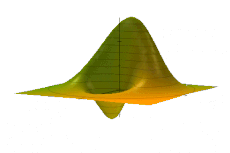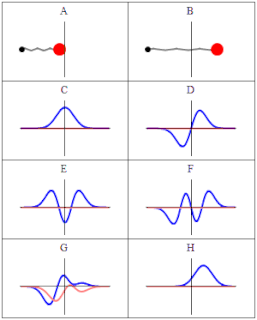The phase space formulation of quantum mechanics places the position and momentum variables on equal footing, in phase space. In contrast, the Schrödinger picture uses the position or momentum representations (see also position and momentum space). The two key features of the phase space formulation are that the quantum state is described by a quasiprobability distribution (instead of a wave function, state vector, or density matrix) and operator multiplication is replaced by a star product .

Quantum mechanics, including quantum field theory, is a fundamental theory in physics which describes nature at the smallest scales of energy levels of atoms and subatomic particles.
In geometry, a position or position vector, also known as location vector or radius vector, is a Euclidean vector that represents the position of a point P in space in relation to an arbitrary reference origin O. Usually denoted x, r, or s, it corresponds to the straight line segment from O to P. In other words, it is the displacement or translation that maps the origin to P:

In Newtonian mechanics, linear momentum, translational momentum, or simply momentum is the product of the mass and velocity of an object. It is a vector quantity, possessing a magnitude and a direction in three-dimensional space. If m is an object's mass and v is the velocity, then the momentum is
Contents
- Phase space distribution
- Star product
- Time evolution
- Examples
- Simple harmonic oscillator
- Free particle angular momentum
- Morse potential
- Quantum tunneling
- Quartic potential
- Schrödinger cat state
- References
The theory was fully developed by Hilbrand Groenewold in 1946 in his PhD thesis, [1] and independently by Joe Moyal, [2] each building on earlier ideas by Hermann Weyl [3] and Eugene Wigner. [4]
Hilbrand Johannes "Hip" Groenewold (1910–1996) was a Dutch theoretical physicist who pioneered the largely operator-free formulation of quantum mechanics in phase space known as phase-space quantization.
José Enrique Moyal was an Australian mathematician and mathematical physicist who contributed to aeronautical engineering, electrical engineering and statistics, among other fields.

Hermann Klaus Hugo Weyl, was a German mathematician, theoretical physicist and philosopher. Although much of his working life was spent in Zürich, Switzerland and then Princeton, New Jersey, he is associated with the University of Göttingen tradition of mathematics, represented by David Hilbert and Hermann Minkowski.
The chief advantage of the phase space formulation is that it makes quantum mechanics appear as similar to Hamiltonian mechanics as possible by avoiding the operator formalism, thereby "'freeing' the quantization of the 'burden' of the Hilbert space". [5] This formulation is statistical in nature and offers logical connections between quantum mechanics and classical statistical mechanics, enabling a natural comparison between the two (cf. classical limit). Quantum mechanics in phase space is often favored in certain quantum optics applications (see optical phase space), or in the study of decoherence and a range of specialized technical problems, though otherwise the formalism is less commonly employed in practical situations. [6]
Hamiltonian mechanics is a theory developed as a reformulation of classical mechanics and predicts the same outcomes as non-Hamiltonian classical mechanics. It uses a different mathematical formalism, providing a more abstract understanding of the theory. Historically, it was an important reformulation of classical mechanics, which later contributed to the formulation of statistical mechanics and quantum mechanics.

The mathematical concept of a Hilbert space, named after David Hilbert, generalizes the notion of Euclidean space. It extends the methods of vector algebra and calculus from the two-dimensional Euclidean plane and three-dimensional space to spaces with any finite or infinite number of dimensions. A Hilbert space is an abstract vector space possessing the structure of an inner product that allows length and angle to be measured. Furthermore, Hilbert spaces are complete: there are enough limits in the space to allow the techniques of calculus to be used.
The classical limit or correspondence limit is the ability of a physical theory to approximate or "recover" classical mechanics when considered over special values of its parameters. The classical limit is used with physical theories that predict non-classical behavior.
The conceptual ideas underlying the development of quantum mechanics in phase space have branched into mathematical offshoots such as algebraic deformation theory (cf. Kontsevich quantization formula) and noncommutative geometry.
In mathematics, deformation theory is the study of infinitesimal conditions associated with varying a solution P of a problem to slightly different solutions Pε, where ε is a small number, or vector of small quantities. The infinitesimal conditions are therefore the result of applying the approach of differential calculus to solving a problem with constraints. One might think, in analogy, of a structure that is not completely rigid, and that deforms slightly to accommodate forces applied from the outside; this explains the name.
In mathematics, the Kontsevich quantization formula describes how to construct a generalized ★-product operator algebra from a given arbitrary finite-dimensional Poisson manifold. This operator algebra amounts to the deformation quantization of the corresponding Poisson algebra. It is due to Maxim Kontsevich.
Noncommutative geometry (NCG) is a branch of mathematics concerned with a geometric approach to noncommutative algebras, and with the construction of spaces that are locally presented by noncommutative algebras of functions. A noncommutative algebra is an associative algebra in which the multiplication is not commutative, that is, for which does not always equal ; or more generally an algebraic structure in which one of the principal binary operations is not commutative; one also allows additional structures, e.g. topology or norm, to be possibly carried by the noncommutative algebra of functions.































